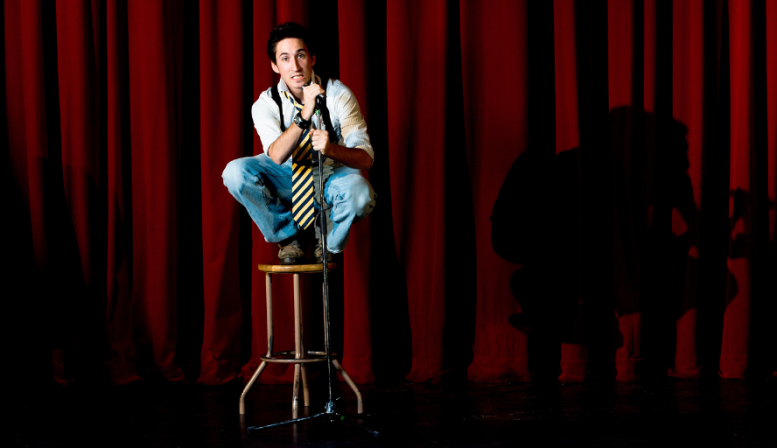Lessons in Public Speaking From a Stand-Up Comedian

Not all public speakers take the same approach, but they do have the same goal in mind—to win over the audience and convey information in a way that is captivating, engaging, and memorable.
I recently had the opportunity to interview a professional stand-up comedian. It was immediately apparent to me that the anecdotes he shared, as well as the advice he gave, were not only applicable to aspiring comedians but could be valuable to anyone who engages in public speaking of any kind.
In fact, as he spoke, I could picture him as an HR manager or sales team leader. Not surprising, since comedians often possess the transferable skills that companies want.
From his stories and advice, I’ve written this short article that I think will be helpful to anyone involved in public speaking—at any level.
What Exactly Goes Into Preparation

Comedians may sometimes appear to be speaking off the cuff or “improvising”, but I can assure you they are not—at least the good ones aren’t.
Being prepared goes beyond simply having the script polished and memorized. Being prepared also entails:
-
Anticipating obstacles and having a plan B, a detour, or amendment in place and ready to go.
-
Knowing the precise timing of the material you are delivering. You may not have a clear understanding of what exactly your presentation is highlighting until you’ve timed it and timed all its sections. You may find that you’re spending too much time on one section to the detriment of another.
-
Knowing the room. This expression is usually used to refer to the audience, but knowing the room, literally, is also very important.
- Understand the acoustics and be prepared to modify your delivery accordingly.
- Understand the seating layout and be prepared to modify how you occupy the space accordingly.
-
Knowing the other speakers/performers. The person or persons who speak before you—and this includes the host or MC—will set the tone for the event. You need to understand what kind of tone they will set so that your presentation does not stick out in a bad way.
-
Knowing the lighting. The stage lighting affects how or if the speaker/performer is able to see the audience.
- The first time I ever bombed on stage was because I didn’t anticipate that the strong lighting would prevent me from making eye contact with the audience. I was thrown off balance and couldn’t recover.
How to Recover From a Poor Opening
I’m fortunate to be able to do what I love to do. But when I stand before a large audience and deliver my carefully crafted, clever opening, and it bombs, in those rare moments, I hate my job.

The truth of the matter is that your ability to recover from a poorly received opening will largely depend on the strength of the material you’ve prepared. However, I have learned from experience how to increase the chances of recovering from a poor opening. And I’ve also learned how to make it more difficult.
What Not To Do
Do not acknowledge, apologize, or self-deprecate
-
What you perceive to be a poor opening might be just that—your perception. The audience—or at least a portion of the audience—might not have noticed, or they might think the opening was quite good. Just because you didn’t get the reaction you anticipated doesn’t mean the audience isn’t engaged. Different audiences show their appreciation in different ways.
-
When you apologize or self-deprecate you draw attention to the misstep. You also show a lack of confidence and are likely to cause the audience to doubt you going forward.
Do not go off script
-
Once you go off script, you’ve immediately failed at what you set out to do—deliver the message you came to deliver. If you follow a poor opening with a poor presentation and a poor ending, at least you will have accomplished your main objective—to deliver the message you prepared to deliver. Then you will need to go back through your material or watch a video of your performance to understand where it went wrong. In the middle of your performance is not the time to do that.
What To Do
Pause, take a breath.
-
Literally, take a moment, a breath. You don’t want to quickly transition into the next part of your set/presentation. Instead, you need to mark the end of the opening with a beat or two of silence. This sets it apart from the rest of your set/presentation. It gives you a new start, as it were.
Move, change position, change perspective
-
Give yourself and your audience a new perspective before you go into the next part of your presentation. A new perspective can be accomplished simply by taking a step or two and facing the audience from a different point on the stage.
-
Making a slight adjustment to your posture or changing how you hold the microphone will help give the next part of your set/presentation a different look and a different feel. You don’t want to acknowledge the weak opening verbally, but you can and should distance yourself from it physically—both for your sake and for that of the audience.
The Little Things That Can Make the Difference
You have good material, and you have a good delivery. Now, take a look at some subtle tips that will help you to give a presentation that is better than the sum of its parts.
Use silence and space in concert
-
I am not a big fan of moving while I’m talking, not counting hand and facial gestures. And I mean that in a literal sense. When I talk, I stand still. I will, however, shift positions or take a step in between sentences when I’m taking a breath, and only in those moments.
-
I’m not suggesting this approach should be used by everyone. But I do recommend paying attention to how you incorporate silence into your presentation, how you handle it, and what you are doing with yourself in those moments.
-
Silence can be unsettling for the audience, but it is necessary. When I reserve movements only to those moments of intentional silence, I am showing the audience that I am still in control, they need not be unsettled. Also, by standing still while I’m speaking, I draw attention to my every sentence.
Milk the cow
-
When I deliver a joke that lands especially well, I’m not quick to get off it. In fact, often I will repeat the punchline. I milk that cow until it’s dry.
-
What I won’t do is repeat the punchline with different words (unless it’s in my script). I will repeat the same punchline with the same words, perhaps changing the inflection and adding a gesture.
-
In smaller venues or in more intimate settings, after having delivered the joke to the audience as a whole, I will focus my attention on a single audience member and deliver the punchline for just that person. It works every time.
The Takeaway
Even if, as a public speaker, you’re not trying to get laughs, the skills and techniques a stand-up comedian might employ to get an audience to focus on and be receptive to the message are just as applicable.
The chances of giving a great presentation, as opposed to a mediocre one, are largely dependent on the material you’ve crafted. And that can’t be understated. Know it frontwards and backwards. And know the timing of each section—how long it takes you to deliver each part of your presentation.
Offer the audience a consistent and predictable visual point to focus on. And incorporate the natural silences and pauses that occur in your presentation in a thought-out and intentional way.
About the author:
Russell Ridgeway is an American writer based in Budapest, Hungary. He works for Lensa and creates freelance content in the business, tech, and fashion industries. He also writes creative fiction. You can reach him by email ([email protected]), or on LinkedIn and other social media platforms.







